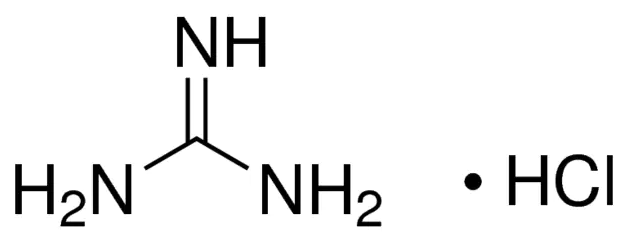Guanidine hydrochloride CAS#: 50-01-1; ChemWhat Code: 70848
Identification
| Product Name | Guanidine hydrochloride |
| IUPAC Name | guanidine;hydrochloride |
| Molecular Structure |  |
| CAS Registry Number | 50-01-1 |
| EINECS Number | 200-002-3 |
| MDL Number | MFCD00013026 |
| Beilstein Registry Number | 3591990 |
| Synonyms | guanidine hydrochlorideguanidinium chlorideguanidinium hydrochlorideguanidine monohydrochlorideguanidine-HClguanidine chlorideguanidine hydrochloride salt |
| Molecular Formula | C5H6N2 |
| Molecular Weight | 94.116 |
| InChI | InChI=1S/C5H6N2/c6-5-2-1-3-7-4-5/h1-4H,6H2 |
| InChI Key | CUYKNJBYIJFRCU-UHFFFAOYSA-N |
| Canonical SMILES | C1=CC(=CN=C1)N |
| Patent Information | ||
| Patent ID | Title | Publication Date |
| CN113563340 | Matrine pyrimidine derivative, and preparation method and application thereof | 2021 |
| US2016/340374 | BORATE-BASED BASE GENERATOR, AND BASE-REACTIVE COMPOSITION COMPRISING SUCH BASE GENERATOR | 2016 |
Physical Data
| Appearance | Colorless to white crystals |
| Solubility | No data available |
| Flash Point | No data available |
| Refractive index | No data available |
| Sensitivity | No data available |
| Melting Point, °C | Solvent (Melting Point) | Comment (Melting Point) |
| 188 | with decomposition | |
| 184.85 | ethanol | |
| 179 – 180 | ||
| 178 – 185 |
| Density, g·cm-3 | Measurement Temperature, °C |
| 1.417 | -173.16 |
| 1.354 |
| Description (Association (MCS)) | Solvent (Association (MCS)) | Temperature (Association (MCS)), °C | Comment (Association (MCS)) | Partner (Association (MCS)) |
| Further physical properties of the complex | 25 | time dependence. Object(s) of Study: concentration dependence | catechol oxidase I | |
| Further physical properties of the complex | CHCl3, methanol | temperature dependence. Object(s) of Study: in the presence of inorganic compounds | C90H126N6O36 | |
| Stability constant of the complex with … | dimethylsulfoxide-d6 | C38H30N6O6(2-)*2K(1+) | ||
| Further physical properties of the complex | tetrahydrofuran | 20 | in the presence of electrolytes. Object(s) of Study: in the presence of additives | C40H48O12 |
| UV/VIS spectrum of the complex | aq. phosphate buffer | ambient temperature | cytochrome c from horse heart |
Spectra
| Description (NMR Spectroscopy) | Nucleus (NMR Spectroscopy) | Solvents (NMR Spectroscopy) | Temperature (NMR Spectroscopy), °C | Frequency (NMR Spectroscopy), MHz |
| Chemical shifts | 13C | water-d2 | ||
| Chemical shifts | 1H | aq. phosphate buffer | 37 | 300 |
| Spin-lattice relaxation time (T1) | ||||
| Second moment of NMR absorption | ||||
| Spectrum | 1H | -153.2 |
| Description (IR Spectroscopy) | Solvent (IR Spectroscopy) | Comment (IR Spectroscopy) |
| Bands, Spectrum | potassium bromide | |
| Bands, Spectrum | dimethyl sulfoxide | |
| Spectrum | water-d2 | |
| Spectrum | not given | 500 cm**-1 – 3500 cm**-1 |
| Description (UV/VIS Spectroscopy) | Solvent (UV/VIS Spectroscopy) | Comment (UV/VIS Spectroscopy) |
| Spectrum | lithium hydroxide monohydrate | |
| UV/VIS | ||
| Spectrum | H2O | 320 – 450 nm |
| Description (Raman Spectroscopy) | Comment (Raman Spectroscopy) |
| Raman | |
| Spectrum | H2O |
| Bands | Zuordnung der Ramanlinien |
| Spectrum | des Krystallpulvers |
Route of Synthesis (ROS)
| Conditions | Yield |
| With hydrazine hydrate monohydrate In 1,4-dioxane at 110℃; for 3h; | 99.5% |
| With hydrazine hydrate monohydrate In 1,4-dioxane for 2h; Heating; | 98% |
| With hydrazine hydrate monohydrate In 1,4-dioxane for 2h; Reflux; | 98% |
Safety and Hazards
| Pictogram(s) |  |
| Signal | Warning |
| GHS Hazard Statements | H302: Harmful if swallowed [Warning Acute toxicity, oral] H315: Causes skin irritation [Warning Skin corrosion/irritation] H319: Causes serious eye irritation [Warning Serious eye damage/eye irritation] Information may vary between notifications depending on impurities, additives, and other factors. |
| Precautionary Statement Codes | P264, P264+P265, P270, P280, P301+P317, P302+P352, P305+P351+P338, P321, P330, P332+P317, P337+P317, P362+P364, and P501 (The corresponding statement to each P-code can be found at the GHS Classification page.) |
Other Data
| Transportation | Under the room temperature and away from light |
| HS Code | No data available |
| Storage | Under the room temperature and away from light |
| Shelf Life | 2 years |
| Market Price | USD |
| Druglikeness | |
| Lipinski rules component | |
| Molecular Weight | 95.5317 |
| logP | -0.134 |
| HBA | 3 |
| HBD | 3 |
| Matching Lipinski Rules | 4 |
| Veber rules component | |
| Polar Surface Area (PSA) | 75.89 |
| Rotatable Bond (RotB) | 0 |
| Matching Veber Rules | 2 |
| Use Pattern |
| Guanidine hydrochloride CAS#: 50-01-1 used as an intermediate of medicine and is an important raw material for the manufacture of sulfadiazine, sulfamethazine, sulfamethazine and folic acid. |
Buy Reagent | |
| No reagent supplier? | Send quick inquiry to ChemWhat |
| Want to be listed here as a reagent supplier? (Paid service) | Click here to contact ChemWhat |
Approved Manufacturers | |
| Caming Pharmaceutical Ltd | http://www.caming.com/ |
| Want to be listed as an approved manufacturer (Requires approvement)? | Please download and fill out this form and send back to approved-manufacturers@chemwhat.com |
Contact Us for Other Help | |
| Contact us for other information or services | Click here to contact ChemWhat |
